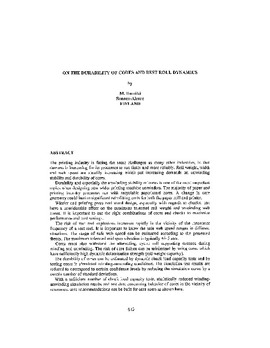| dc.contributor.author | Ilomaki, M. | |
| dc.contributor.other | International Conference on Web Handling (2005) | |
| dc.date.accessioned | 2019-11-08T22:56:47Z | |
| dc.date.available | 2019-11-08T22:56:47Z | |
| dc.date.issued | 2005-06 | |
| dc.identifier | oksd_icwh_2005_ilomaki | |
| dc.identifier.citation | Ilomaki, M. (2005, June). On the durability of cores and rest roll dynamics. Paper presented at the Eighth International Conference on Web Handling (IWEB), Stillwater, OK. | |
| dc.identifier.uri | https://hdl.handle.net/11244/321879 | |
| dc.description.abstract | The printing industry is facing the same challenges as many other industries, in that demand is increasing for its processes to run faster and more reliably. Roll weight, width and web speed are steadily increasing which put increasing demands on unwinding stability and durability of cores. | |
| dc.description.abstract | Durability and especially the unwinding stability of cores is one of the most important topics when designing new wider printing machine unwinders. The majority of paper and printing industry processes run with recyclable paperboard cores. A change in core geometry could lead to significant retrofitting costs for both the paper mill and printer. | |
| dc.description.abstract | Winder and printing press reel stand design, especially with regards to chucks, can have a considerable effect on the maximum tolerated roll weight and unwinding web speed. It is important to use the right combinations of cores and chucks to maximize performance and cost savings. | |
| dc.description.abstract | The risk of rest reel explosions increases rapidly in the vicinity of the resonance frequency of a rest reel. It is important to know the safe web speed ranges in different situations. The range of safe web speed can be estimated according to the presented theory. The maximum tolerated mid span vibration is typically +/-5 mm. | |
| dc.description.abstract | Cores must also withstand the alternating, cyclic roll supporting stresses during winding and unwinding. The risk of core failure can be minimized by using cores which have sufficiently high dynamic delamination strength (roll weight capacity). | |
| dc.description.abstract | The durability of cores can be estimated by dynamic chuck load capacity tests and by testing cores in simulated winding-unwinding conditions. The simulation test results are reduced to correspond to certain confidence levels by reducing the simulation curve by a certain number of standard deviations. | |
| dc.description.abstract | With a sufficient number of chuck load capacity tests, statistically reduced winding-unwinding simulation results and test data concerning behavior of cores in the vicinity of resonance, core recommendations can be built for core users as shown here. | |
| dc.format | application/pdf | |
| dc.language | en_US | |
| dc.publisher | Oklahoma State University | |
| dc.rights | In the Oklahoma State University Library's institutional repository this paper is made available through the open access principles and the terms of agreement/consent between the author(s) and the publisher. The permission policy on the use, reproduction or distribution of the article falls under fair use for educational, scholarship, and research purposes. Contact Digital Resources and Discovery Services at lib-dls@okstate.edu or 405-744-9161 for further information. | |
| dc.title | On the durability of cores and rest roll dynamics | |
| osu.filename | oksd_icwh_2005_ilomaki.pdf | |
| dc.type.genre | Conference proceedings | |
| dc.type.material | Text | |
